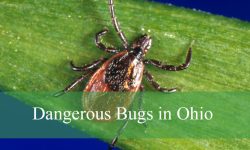Explore 11 diverse types of wolf spiders found in California, complete with detailed identification information and stunning pictures. Learn about these fascinating arachnids and their unique characteristics.
Learn about wolf spiders and their characteristics
Wolf spiders are a family of spiders known as Lycosidae, and they belong to the order Araneae. These spiders are named “wolf spiders” because of their hunting behavior, which is somewhat reminiscent of wolves. They are a diverse and widespread group of spiders found in various habitats around the world, including North America, Europe, Asia, and Australia. Here are some key characteristics and features of wolf spiders:
– Appearance: Wolf spiders come in various sizes, but they are generally robust and sturdy in build. They have two main body parts, the cephalothorax (head and thorax combined) and the abdomen. Their coloration varies and often helps them blend into their surroundings, with shades of brown, gray, or black. Many wolf spiders have distinctive patterns on their bodies.
– Eyes: One of the most distinctive features of wolf spiders is their eye arrangement. They typically have eight eyes arranged in three rows. The arrangement may vary slightly among species, but it provides them with excellent vision, particularly at night.
– Hunting Behavior: Wolf spiders are active hunters, and they do not build webs to catch prey like some other spider species. Instead, they stalk and chase their prey on the ground. They are fast runners and pounce on insects and other small creatures, using their strong legs to immobilize their prey.
– Venom: Wolf spiders are venomous, but their venom is not considered medically significant to humans. While their bite may be painful and cause some local swelling, it is not dangerous to most people and is typically less severe than the bite of some other spiders, like the black widow or brown recluse.
– Maternal Care: Many wolf spider species exhibit maternal care. The female wolf spider carries her egg sac with her and, once the spiderlings hatch, she carries them on her abdomen until they are old enough to fend for themselves.
– Habitats: Wolf spiders can be found in a wide range of habitats, including grasslands, forests, deserts, and even gardens. They are adaptable and have evolved to thrive in various environmental conditions.
– Nocturnal Predators: Most wolf spiders are nocturnal, meaning they are active at night. They use their keen eyesight to hunt for prey in the dark.
– Molt: Like other arachnids, wolf spiders molt to grow. They shed their exoskeleton periodically throughout their life, leaving behind a fragile, new exoskeleton that hardens over time.
Common types of wolf spiders in California
California is home to a wide variety of wolf spiders, and in this article, we’ll delve into 11 distinct species found in the state. We’ll provide you with essential identification details and showcase captivating images of these arachnids, allowing you to gain a deeper understanding of their unique characteristics.
Tigrosa helluo
The wolf spider Tigrosa helluo, a member of the Lycosidae family, is indigenous to North America and can be found in the US, Canada, and Mexico. With a propensity for wetter conditions, it can be found in a variety of habitats, including forests, marshes, fields, and riparian areas. The average lifespan of a male is around a year, whereas that of a female is about two years.
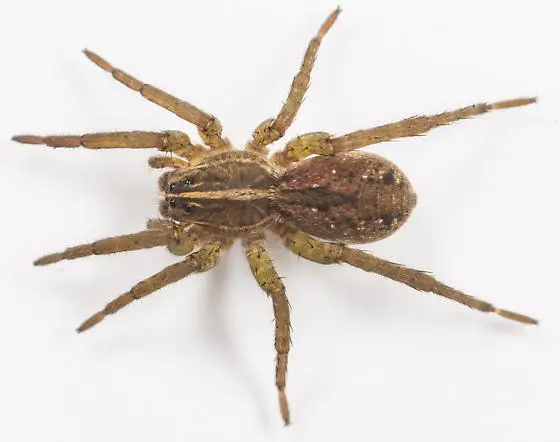
The brown carapace of T. helluo has a distinct yellow stripe extending from its anterior eyes down the cephalothorax, which is one of its distinguishing characteristics. T. helluo can be distinguished from other wolf spiders by its unique black markings on the underside of the abdomen. T. helluo is one of the smaller wolf spider species, with an average size of about 17 mm (0.67 in), and sexual dimorphism is evident in that females are typically larger than males.
Koch’s Wolf Spider (Alopecosa kochi)
Alopecosa kochi, a member of the wolf spider family, is known for its bilaterally symmetric body. These spiders can reach a length of up to 16 mm, with a carapace that measures about 4.67 mm in length and 3.3 mm in width. Like all living organisms, they are multicellular, composed of multiple cells organized into tissues and organs.
The geographic distribution of Alopecosa kochi encompasses the United States. These spiders have an exoskeleton, providing them with protection and structural support. They are classified as carnivores, primarily preying on other animals for sustenance. Additionally, their visual system includes corneal eyes, indicating specialized visual organs.
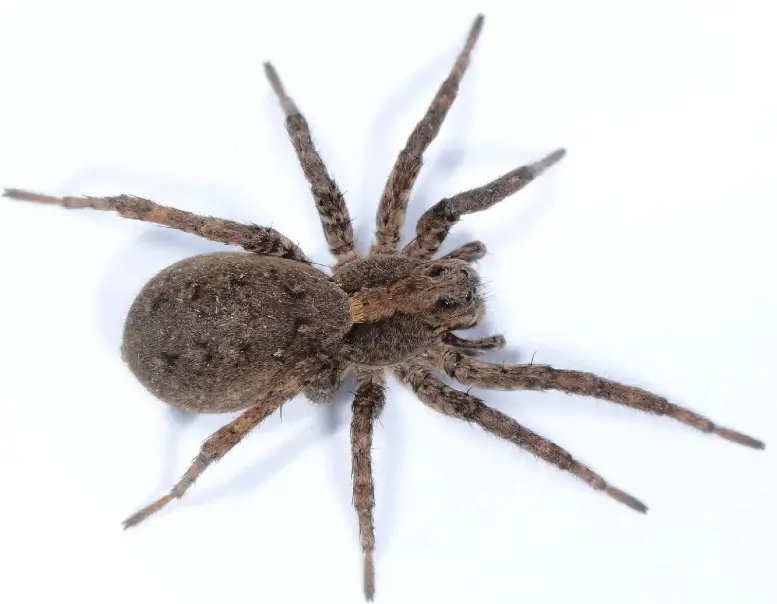
These attributes collectively contribute to the intriguing nature of Alopecosa kochi and its role as a carnivorous predator within its habitat in the United States.
The Koch’s wolf spider exhibits the intriguing behavior of “thanatosis,” where it pretends to be dead to deter predators. This primarily nocturnal spider preys on insects and smaller spiders. Although it possesses a venomous bite, it poses minimal risk to humans, typically causing mild irritation
Allocosa Subparva
The wolf spider species Allocosa subparva, which belongs to the Lycosidae family, is widespread in western North America, from Oregon and Idaho in the north to Nayarit, Mexico, in the south.
The body size of these little wolf spiders varies, with males measuring between 4.8 and 7.9 mm (0.18 and 0.31 in) and females between 5.9 and 7.3 mm (0.22-0.36 in). Their carapace is reddish-brown to black in color with a smudged central line, dark lateral borders, and no setae. There are two black rings on each femur and tibia, and the sternum, chelicerae, and legs can be any color between orange and black. Their venters occasionally have paired, dark longitudinal stripes, and their abdomens are normally dull yellow with black dorsal dots.
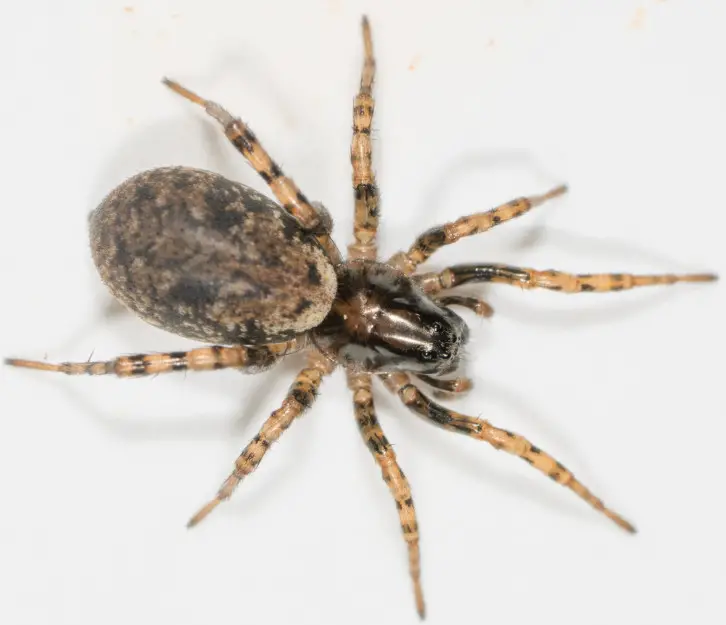
Distinguishing male Allocosa subparva from visually similar species involves observing the distal process of the median apophysis, which is folded and covers (or nearly covers) the basal process. Additionally, the base of the embolus is visible when viewed ventrally. In females, the presence of an epigynum with a dorsal excavation visible through the ventral wall and open dorsally sets them apart.
Schizocosa ocreata
North America is home to the wolf spider species Schizocosa ocreata, which belongs to the Lycosidae family. Because of its distinctive dark-colored fur-like coverings around its legs, the Schizocosa ocreata is a spider that is most frequently referred to as the “brush-legged wolf spider”. Usually in the central and eastern United States, Schizocosa ocreata is widespread throughout North American states.
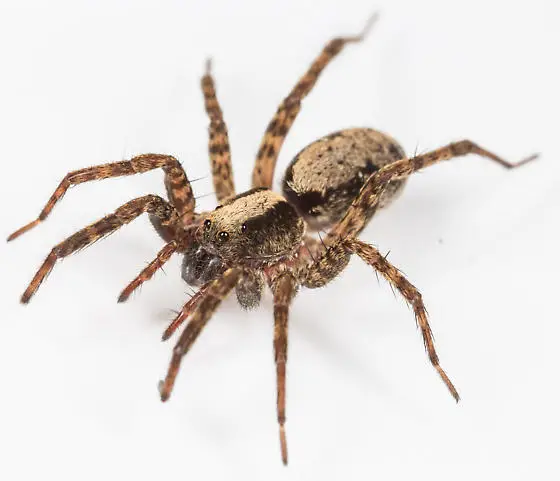
The black hairy legs of the S. ocreata set it apart from other spiders of the Schizocosa genus. Additionally, the sole physical trait that separates this spider from its related species is the pair of bristle tufts on the male, which is a secondary sexual characteristic.
Pirate Otter Spider (Pirata piraticus)
A species of wolf spider belonging to the Lycosidae family is called Pirata piraticus. It may be found in North America, Europe, Turkey, the Caucasus, a stretch from Central Asia to the Far East, China, and Japan.
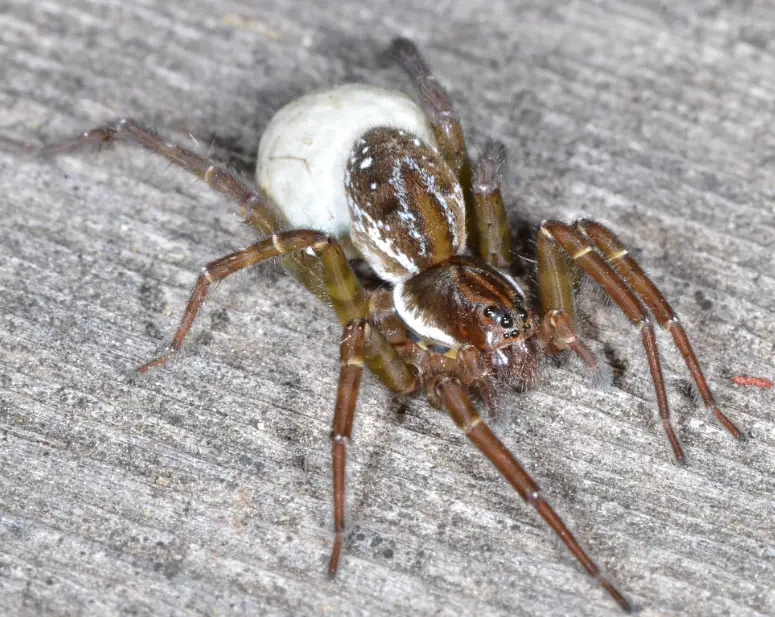
The uncommon Pirate Otter Spider has intriguing activities and feeding patterns. They are noted for their hunting and swimming prowess and mostly eat insects. Although there have been no documented health dangers directly related to this spider, it is nevertheless advisable to engage with animals with caution and respect. The pirate otter spider stands apart within its genus and provides fascinating insights on how adaptable arachnids are.
Arctic wolf spider (Pardosa glacialis)
The Arctic wolf spider, scientifically known as Pardosa glacialis, is a unique member of the Pardosa genus, primarily found in the Arctic, especially in Greenland. These spiders can live for at least two years and grow up to 1.6 inches (4 centimeters) in length. They are carnivores and adapt to the challenging Arctic environment.
A decade-long study on Arctic wolf spiders revealed an intriguing 2 percent increase in their exoskeleton thickness, likely due to longer summers in their habitat. Larger adult females tend to produce more offspring, but these spiders also engage in cannibalistic behavior to control their population.
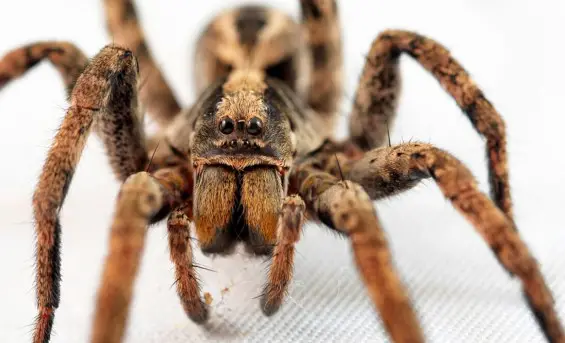
Climate change affects their breeding patterns, with quicker thawing leading to the earlier production of the first clutch and delayed second clutches. The size of the female influences the first clutch’s size, while the second clutch’s size remains independent of the parent’s body size. These adaptations highlight their resilience in changing environments.
Funnel Web Wolf Spiders
One of the only spider genera in the family Lycosidae that produces a sizable funnel-web like that of the Agelenidae is Sosippus, along with the other genera in the subfamily Hippasinae. When compared to other wolf spiders, the posterior spinnerets are longer.
The three rows of their eyes are as follows: two huge eyes in the second row, two larger lateral eyes in the third, and four small eyes in the anterior (lowest) row.Sosippus can be found in the southern United States and Central America
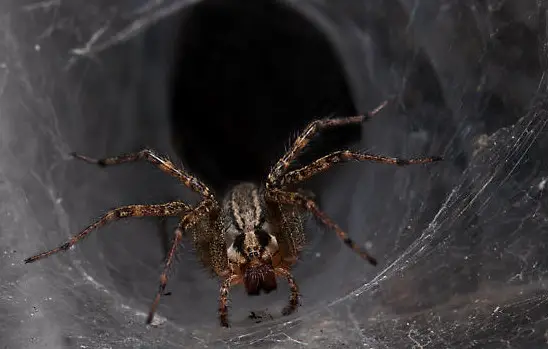
Despite the fact that wolf spiders often hunt on the go, one peculiar subfamily of wolf spiders spends its days immobile building webs. The horizontal funnel-shaped sheet webs that funnel-web wolf spiders construct serve as both a hunting platform and a haven.
Pardosa
The broad wolf spider genus Pardosa is also referred to as the thin-legged wolf spiders. They have distinct, middle, and lateral bands on their carapace and are tiny to medium-sized wolf spiders. They have lengthy spines on the foot and rather long legs.
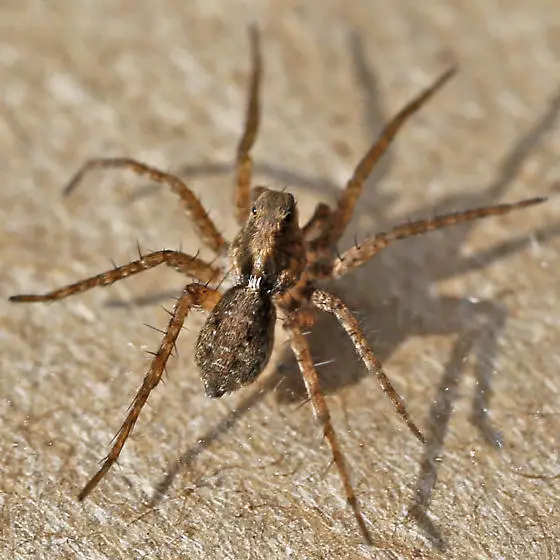
A few species can be found in the Netherlands and Belgium, however the majority of species are located throughout Europe and North America.
Rabidosa rabida
The Lycosidae family of spiders, which includes the rabid wolf spider, is found in North America. Its scientific name is Rabidosa rabida. It can be found across a large area of the United States, from Maine to Florida and westward to Texas.
The cephalothorax of this spider has two dark stripes, the abdomen has one stripe, and it is primarily yellow in color. Males are around half the size of females and attain a body length of about one inch. They have a peculiar arrangement of eight eyes, like a spider’s moustache.

Hogna Antelucana
A species of wolf spider belonging to the Lycosidae family is called Hogna antelucana. It can be found in the US.
The Hogna antelucana doesn’t entangle its prey using complex web constructs like many of its arachnid rivals do. Instead, it takes a proactive approach to hunting, pursuing and ambushing its prey.
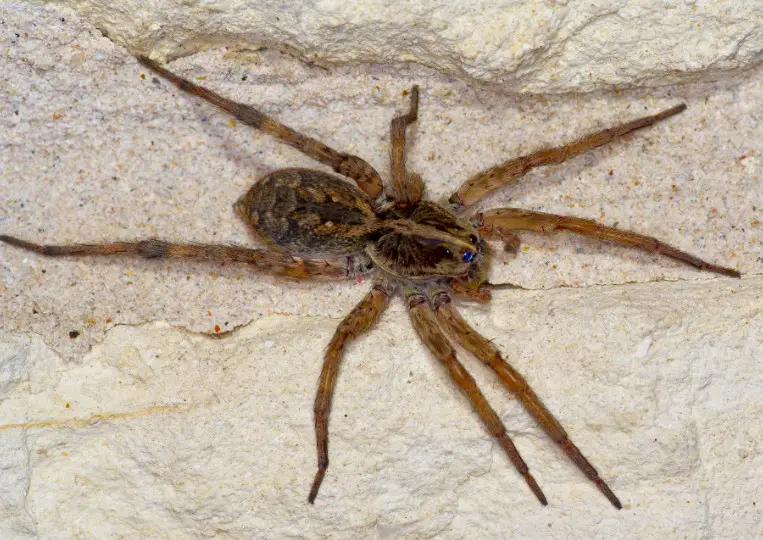
Hogna Antelucana is a wolf spider known for its distinct features. These spiders typically measure between 1.2 to 2.5 cm in size and are characterized by their tan body adorned with dark markings on both the carapace and abdomen. What sets them apart is their unique arrangement of eight eyes: four large ones encircling the head and an additional set of four, slightly smaller, positioned in front of the face.
Shoreline Wolf Spider (Arctosa littoralis)
In North and Central America, there is a particular species of wolf spider called Arctosa littoralis, also referred to as the beach wolf spider. Females of this species tend to their eggs under rocks and other shelter, in contrast to most wolf spiders, which take their egg sacs with them. When a spiderling is born, it rides on its mother’s back until its first molt, which usually takes place between 11 to 14 days.
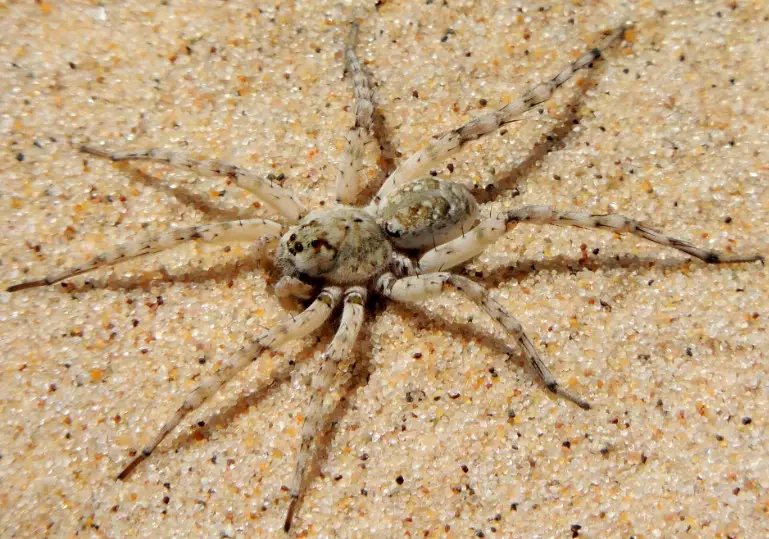
In contrast to other Lycosidae genera, these spiders exhibit both nocturnal and day activity. While adults can be spotted in a variety of settings, including direct sunshine, immature Arctosa littoralis are typically located in moist microhabitats like those found beneath leaf litter, logs, boards, and rocks.
They are distinguished by their large size (up to 15mm in body length), mottled sand or clay color, light spots on the abdomen, and banded legs. They also have a distinctive eye arrangement that is typical of wolf spiders, with large posterior lateral eyes set well back from even larger posterior median eyes, as well as a row of smaller anterior eyes. On the other hand, in this species, the anterior median eyes are almost two times larger than the anterior lateral eyes.
Conclusion
California’s wolf spider diversity is captivating. From Koch’s Wolf Spider with its unique “thanatosis” behavior to the hardy Arctic Wolf Spider, these arachnids play vital roles in their ecosystems. Whether you’re an arachnologist, a spider enthusiast, or just curious about nature, exploring these 12 wolf spider species offers an exciting journey. Their distinct features and behaviors make them intriguing subjects of study. Appreciating their biodiversity is crucial for conserving California’s ecosystems. So, the next time you encounter a wolf spider in US, take a moment to admire their beauty and importance in the natural world.
People Who Read This Also Read:


